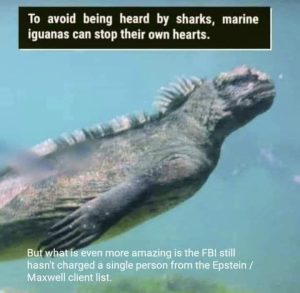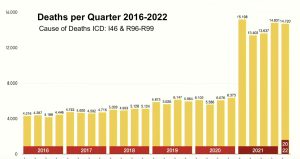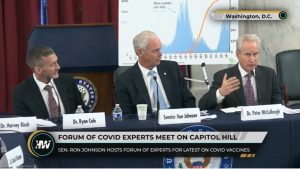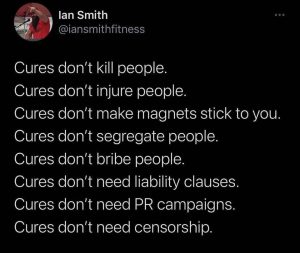
Marine Iguana

New German data reveals that, sudden deaths with unknown cause have increased by 3x since the start of vaccination in 2021!

10-Minute Summary Of U.S. Senator Ron Johnson’s 3-Hour Washington D.C. COVID-19 Roundtable Meeting

Summary of U.S. Sen. Ron Johnson’s roundtable discussion on COVID-19 Vaccines: What They Are, How They Work, and Possible Causes of Injuries, to shed light on the current state of knowledge surrounding the vaccine and the path forward. Medical experts and doctors who specialize in COVID-19 vaccine research and treatment joined Senator Johnson at the roundtable. December 7, 2022.
Be An Enthusiast

Rotten Apple – You really want to advertise your iPhone with every email?

“In spite of its pretty face and attractive products, Apple has some of most deplorable labor practices of any American multi-national. I wrote earlier that Steve Jobs’ real innovation was in finding a firm – Foxconn – that would build a one-million employee concentration camp where it could manufacture and assemble iphones while the one million young workers were living on the brink of starvation. I noted too that Apple was sitting on a cash pile of $150 billion (then increased to $200 billion), but that entire cash pile was stolen from the workers who made Apple’s products. If Steve Jobs had paid those employees anything resembling a living wage, Apple’s cash pile would be zero. Steve Jobs wanted Apple to be profitable, with a margin of about 40%, but Apple’s profits did not come from designing and selling cool products; they came from the theft of wages from society’s most vulnerable young people who needed a job and a start in life. To succeed in his quest, Jobs first had to ensure they failed in theirs. And he did. Even in an internal company report, Apple admitted the “sweatshop” conditions inside the factories that make and assemble its products, admitting that at least 55 of its 102 factories were making staff work more than 60 hours per week, that only 65% were paying legal minimum wages or statutory benefits and that 24 factories paid nothing near China’s minimum wage. The pressure placed on these young people for higher productivity was truly unconscionable, with dozens of young people committing suicide, a fact which did not escape the attention of either Steve Jobs or Tim Cook but which resulted in no action. A human rights organisation accused Foxconn of having an “inhumane and militant” management, the executives of neither Foxconn nor Apple being available for comment.”
Nations Built On Lies – How the US Became Rich, by Larry Romanov, free download at https://www.bluemoonofshanghai.com/books/ (and mind blowing btw)
See also his current articles (English) on Apple.
(I think I’m going to start sending this in reply to every email I get that says “Sent from my iPhone”.)
Climate Science’s Myth-Buster by Guy Sorman

We’ve all come across the images of polar bears drifting on ice floes: emblematic victims of the global warming that’s melting the polar ice caps, symbols of the threat to the earth posed by our ceaseless energy production—above all, the carbon dioxide that factories and automobiles emit. We hear louder and louder demands to impose limits, to change our wasteful ways, so as to save not only the bears but also the planet and ourselves.
In political discourse and in the media, major storms and floods typically get presented as signs of impending doom, accompanied by invocations to the environment and calls to respect Mother Nature. Only catastrophes seem to grab our attention, though, and it’s rarely mentioned that warming would also bring some benefits, such as expanded production of grains in previously frozen regions of Canada and Russia. Nor do we hear that people die more often of cold weather than of hot weather. Isolated voices criticize the alarm over global warming, considering it a pseudoscientific thesis, the true aim of which is to thwart economic modernization and free-market growth and to extend the power of states over individual choices.
Not being a climatologist myself, I’ve always had trouble deciding between these arguments. And then I met Judith Curry at her home in Reno, Nevada. Curry is a true climatologist. She once headed the department of earth and atmospheric sciences at the Georgia Institute of Technology, until she gave up on the academy so that she could express herself independently. “Independence of mind and climatology have become incompatible,” she says. Do you mean that global warming isn’t real? I ask. “There is warming, but we don’t really understand its causes,” she says. “The human factor and carbon dioxide, in particular, contribute to warming, but how much is the subject of intense scientific debate.”
Finish reading: https://www.city-journal.org/global-warming
New ADHD Guideline Will Put More Kids at Risk of ADHD Drugs
A new Australian ADHD guideline has been released. Intended users include parents and those who care for children. The Guideline violates parental rights and lacks vital information about potentially dangerous ADHD drugs and the conflicts of interest declarations of the authoring group and those involved in its writing. The conflicts of interest listed below were obtained by CCHR’s research.1
History of Conflicts of Interests
The Australian ADHD Professionals Association (AADPA) were given $1.5 million of tax payers money to develop a guideline for ADHD.2 However, the guideline is littered with a history of conflicts of interest with drug companies who make ADHD drugs. At least three of AADPA’s recent annual conferences have been sponsored by ADHD drug company manufacturers: Two of these conferences by Novartis who manufacture Ritalin (methylphenidate) and three conferences by Takeda who make Vyvanse (lisdexamfetamine).
Conflicts of interest are not declared in the Guideline,
something public expect when it is their tax payer money and vulnerable children that are affected.
Prof. Mark Bellgrove, Corresponding Author of the ADHD Guideline and President of AADPA has received a research grant from Eli Lilly, manufacturers of the ADHD drug Strattera. He has also given educational talks sponsored by Janssen-Cilag who manufacture Australia’s most prescribed ADHD drug, Concerta.3
Daryl Efron, member of the new Guideline’s Development Group has declared in the past that he has been on ADHD advisory boards for Novartis and Eli Lilly.4
Psychiatrist Bruce Singh, also a member of the Development Group, has declared in the past that he has consulted to and received speakers fees, received funding, and travel consultation from Eli Lilly and Janssen-Cilag.5
The ADHD drugs recommended in the Guideline and their accompanying information sheets do not include vital information for parents and carers of children. Such as the boxed warning for the risk of suicidal behaviour in children taking the ADHD drug atomoxetine (Strattera, an antidepressant) placed on it by Australia’s drug regulatory agency, the Therapeutic Goods Administration (TGA).6
The TGA have received 56 adverse drug reaction reports for Strattera for suicidal ideation, suicide attempts, suicidal behaviour, and suicide. This includes the suicide of a 9-year-old boy on Strattera, and two 7-year-old girls who attempted suicide while on Strattera.7
The Guideline also fails to inform parents that Ritalin and Concerta’s Product Information (PI – information doctors use to prescribe) state that adverse events reported for these drugs include suicide, suicide attempts and suicidal ideation. Dexamfetamine’s PI states there can be “psychotic episodes at recommended doses” and side effects from overdose of the drug may include suicidal or homicidal tendencies.8
Methylphenidate (Ritalin, Concerta and other brands), dexamfetamine or lisdexamfetamine are recommended as the first-line drug choice.9
These drugs are in the same category as cocaine, morphine and opium.10
Despite this, the Guideline indicates that these types of drugs can be given to children under 5 years of age.11
So called symptoms of ADHD include, “is often on the go, gets distracted, squirms or fidgets when sitting, does not listen when spoken to, talks too much, interrupts others, loses toys, pencils or books.”12 Normal childhood behaviour is being turned into a “mental disorder.”
Australia already had 5,450 children aged under 6 years of age on a drug for ADHD in 2021.13
Underlying all of this, is one of the manuals the new ADHD Guideline say should be used to diagnose a child with ADHD, psychiatry’s main manual used in Australia, the Diagnostic and Statistical Manual of Mental Disorders (DSM). The DSM states:
“There are no laboratory tests, neurological assessments or attentional assessments that have been established as diagnostic in the clinical assessment of Attention Deficit/Hyperactivity Disorder.”
The DSM also states, “Signs of the disorder may be minimal or absent when the person is receiving frequent rewards for appropriate behaviour, is in a novel setting, is engaged in especially interesting activities, or is in a one-to-one situation (e.g., clinician’s office)”.
Also stated in the DSM, “There are no specific physical features associated with Attention Deficit/Hyperactivity Disorder.”14
Therefore psychiatry itself is saying you can’t see it, you can’t test for it, and it probably won’t be there when the child is taken to the psychiatrist. Yet the new ADHD guideline is demanding more money to expand services.
Parents are not being told the truth about ADHD, and parental rights to informed consent are being violated.
But the real cost is not money, it’s the lives of our vulnerable children.
In 2007, Australian ADHD guidelines were drafted that heavily relied upon disgraced US psychiatrist, Joseph Biederman. They were subsequently scrapped due to his extensive conflicts of interest. At that time there were 46,586 children on ADHD drugs.
In 2020 this had skyrocketed 260% to 167,950 children aged 0-18 years old on drugs for ADHD.15 Astoundingly, disgraced Biederman is referenced 9 times in the new Guideline.16
Other AADPA conflicts of interest include:
Board member Dr Roger Patterson has been a recipient of speakers fees from Janssen, Eli Lilly, Novartis, and has been a paid Advisory Board member for Eli Lilly as well as having received conference sponsorship from Janssen-Cilag, Eli Lilly and Novartis.17
Vice President, psychiatrist David Coghill has received honoraria from advisory boards/speaking from Eli Lilly, Janssen Cilag and Novartis, all manufacturers of ADHD drugs.18
Coghill is also doing a trial on young adults with autism, giving them the psychedelic drug ecstasy (MDMA), which can also act as a hallucinogen.19
Where is the transparency parents and professionals expect?
On page 199, the ADHD Guideline states that a copy of the Conflicts of Interest declarations can be requested from AADPA via email. CCHR has requested the Conflicts of Interest declaration three times already but has yet to receive them.
Please email AADPA at guidelines@aadpa.com.au and request a copy of their Conflicts of Interest declarations.20
Let CCHR know if you receive them.
We all want the very best for our children. Children can and do have difficulties in life, sometimes severe. But it is imperative the cause of the problem for each child is found and rectified, first starting with a full physical examination to rule out any undiagnosed underlying medical condition that could be manifesting as unwanted or disruptive behaviour or pain. Parents should never be satisfied with a mere explanation or subjective opinion about behavioural symptoms. Ask the psychiatrist to prove the diagnosis – they can’t.
For more information on ADHD and alternatives to the psychiatric drugging of our children go to cchr.org.au
Caution: No one should stop taking any psychiatric drug without the advice and assistance of a competent medical doctor.
References:
Australian Evidence-Based Clinical Practice Guideline for Attention Deficit Hyperactivity Disorder (ADHD), Melbourne: Australian ADHD Professionals Association, 2022, pages 5, 37. To obtain a copy fill out the form on this link, https://adhdguideline.aadpa.com.au/
“A. Who is funding the guidelines?” Minute, 6 September 2019, Reference number CBR19-00245, “Evidence-based guideline for diagnosis, management and treatment of attention deficit hyperactivity disorder (ADHD), Freedom of Information Requests: 019 and 020, 16 June 2022, https://www.nhmrc.gov.au/about-us/freedom-information/foi-disclosure-log
Australian ADHD Professionals Association, website, https://aadpa.com.au/about-aadpa/ accessed 17 October 2022.
“Prof. Mark Bellgrove, AADPA President (29 July 2017 – Present), Disclosure,” AADPA website, accessed 8 October 2022, https://aadpa.com.au/about-aadpa/board-of-directors/#mark-bellgrove
“Appendix B: Dualities and conflicts of interest summary,” Draft Guidelines on Attention Deficit Hyperactivity Disorder, June 2009, p. 4.
Tim J Lamberts, Bruce S Singh, Maxine X Patel, “Community treatment orders and antipsychotic long-acting injections,” British Journal of Psychiatry, 2009, s57, https://www.cambridge.org/core/services/aop-cambridge-core/content/view/B4BDC8EC7AA1102A4A62E33A8FC46E48/S0007125000246035a.pdf/div-class-title-community-treatment-orders-and-antipsychotic-long-acting-injections-div.pdf ; B Singh, “Recognition and optimal management of schizophrenia and related psychoses,” Internal Medicine Journal, 1 July 2005, https://www.deepdyve.com/lp/wiley/recognition-and-optimal-management-of-schizophrenia-and-related-doj1hvNMZn
“Australian Product Information, Strattera (atomoxetine hydrochloride),” 6 May 2022, https://www.ebs.tga.gov.au/ebs/picmi/picmirepository.nsf/pdf?OpenAgent=&id=CP-2010-PI-04269-3&d=20221008172310101
“Database of Adverse Event Notifications ̶ medicines,” Therapeutic Goods Administration, Enter drug name in the search box https://apps.tga.gov.au/PROD/DAEN/daen-entry.aspx Case numbers: 309495, 205312, 328837.
“Australian Product Information, Concerta (methylphenidate hydrochloride),” 21 October 2021, https://www.ebs.tga.gov.au/ebs/picmi/picmirepository.nsf/pdf?OpenAgent=&id=CP-2009-PI-00919-3 ; “Australian Product Information, Aspen dexamfetamine (dexamfetamine sulfate), 15 October 2021, p. 7, 8, https://www.ebs.tga.gov.au/ebs/picmi/picmirepository.nsf/pdf?OpenAgent=&id=CP-2017-PI-01667-1 ; “Australian Product Information, Ritalin© 10/Ritalin LA (methylphenidate),” 6 April 2022, https://www.ebs.tga.gov.au/ebs/picmi/picmirepository.nsf/pdf?OpenAgent=&id=CP-2010-PI-03175-3
Australian Evidence-Based Clinical Practice Guideline for Attention Deficit Hyperactivity Disorder (ADHD), Melbourne: Australian ADHD Professionals Association, 2022, p. 24. To obtain a copy fill out the form on this link, https://adhdguideline.aadpa.com.au/download
The Poisons Standard (The SUSMP), Australian Federal Government, October 2022, pp. 1, X, 261, 262, 263, https://www.legislation.gov.au/Details/F2022L01257
Australian Evidence-Based Clinical Practice Guideline for Attention Deficit Hyperactivity Disorder (ADHD), Melbourne: Australian ADHD Professionals Association, 2022, p. 24, To obtain a copy fill out the form on this link, https://adhdguideline.aadpa.com.au/download
Diagnostic and Statistical Manual of Mental Disorders, Fourth Edition, Text Revision, DSM-IV-TR, American Psychiatric Association, p. 92.
Attention Deficit Hyperactivity Disorder: Utilisation Analysis, Drug utilisation sub-committee (DUSC), June 2021, p. 17, https://www.pbs.gov.au/industry/listing/participants/public-release-docs/2021-06/guanfacine-prd-2021-06-FINAL.PDF
Diagnostic and Statistical Manual of Mental Disorders, Fourth Edition, Text Revision, DSM-IV-TR, American Psychiatric Association, pp. 86, 87, 88, 89; Australian Evidence-Based Clinical Practice Guideline for Attention Deficit Hyperactivity Disorder (ADHD), Melbourne: Australian ADHD Professionals Association, 2022, p. 13. To obtain a copy fill out the form on this link, https://adhdguideline.aadpa.com.au/download
“New ADHD guidelines: a prescription for more than just Ritalin,” The Conversation, 21 November 2011, https://theconversation.com/new-adhd-guidelines-a-prescription-for-more-than-just-ritalin-4387 ; Freedom of Information Request No: 112/0708, Department of Health and Ageing, 2008, Part 1: https://cchr.org.au/wp-content/uploads/2017/02/Part-1-of-numbers-on-ADHD-drugs-2007.pdf Part 2: https://cchr.org.au/wp-content/uploads/2016/08/Part-2-of-Numbers-on-ADHD-Drugs-in-2007.pdf ; Attention Deficit Hyperactivity Disorder: Utilisation Analysis, Drug utilisation sub-committee (DUSC), Junehttps://cchr.org.au/wp-content/uploads/2016/08/Part-2-of-Numbers-on-ADHD-Drugs-in-2007.pdf1-06/guanfacine-prd-2021-06-FINAL.PDF
Australian Evidence-Based Clinical Practice Guideline for Attention Deficit Hyperactivity Disorder (ADHD), Melbourne: Australian ADHD Professionals Association, 2022, pp. 177, 178, 180, 181, 183, 187, To obtain a copy fill out the form on this link, https://adhdguideline.aadpa.com.au/download
“Dr Roger Patterson, Director (29 July 2017 – present) Disclosure,” https://aadpa.com.au/about-aadpa/board-of-directors/#roger-paterson
“Prof, David Coghill, Vice President (29 July 2017 – Present) Disclosure,” https://aadpa.com.au/about-aadpa/board-of-directors/#david-coghill
“RANZCP Foundation congratulates psychiatrists awarded MRFF funding,” RANZCP Foundation, 11 Feb. 2022, https://www.ranzcp.org/news-policy/news/ranzcp-foundation-congratulates-psychiatrists
Australian Evidence-Based Clinical Practice Guideline for Attention Deficit Hyperactivity Disorder (ADHD), Melbourne: Australian ADHD Professionals Association, 2022, p. 199. To obtain a copy fill out the form on this link, https://adhdguideline.aadpa.com.au/download
What Cures Are Not

A Year to Live

